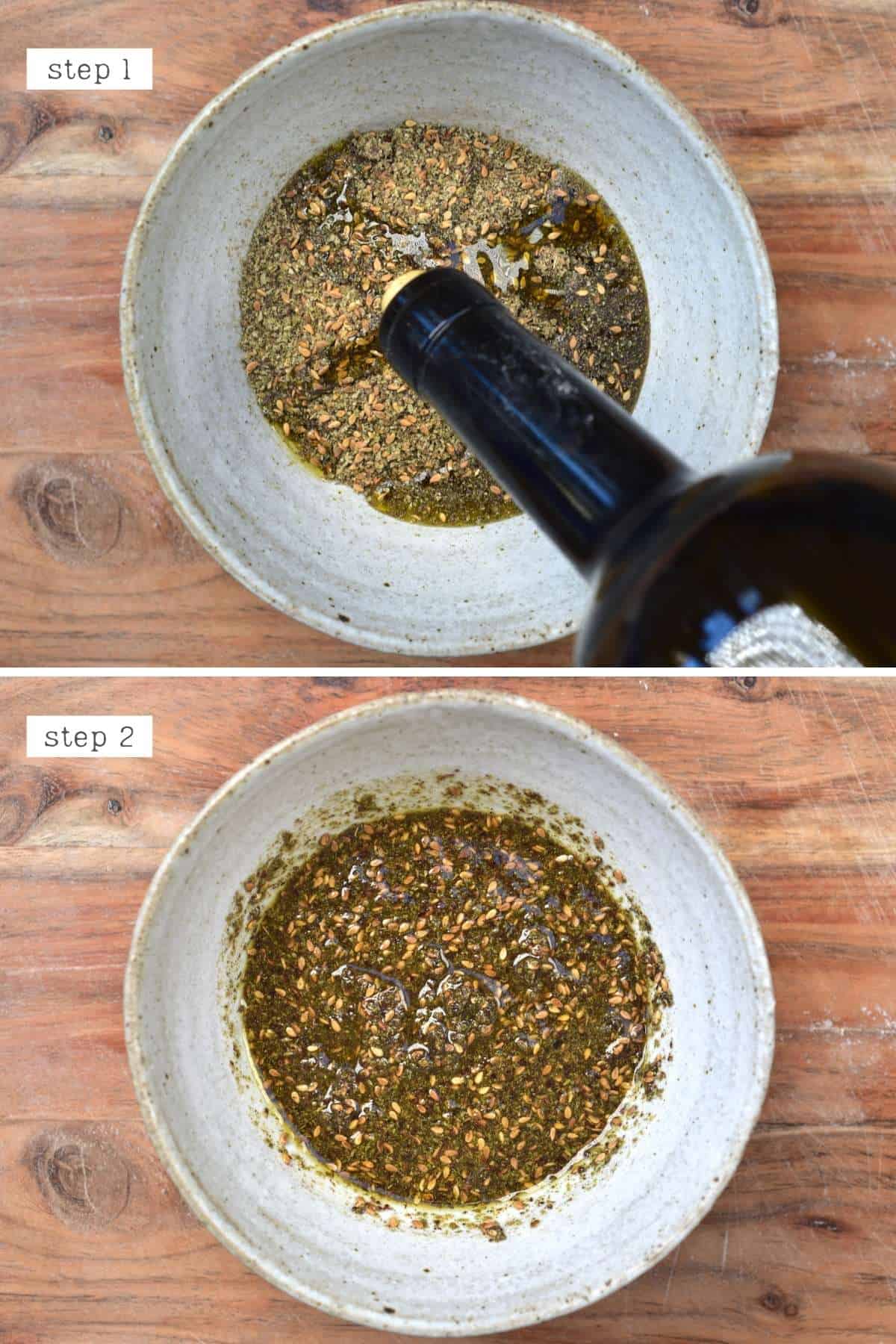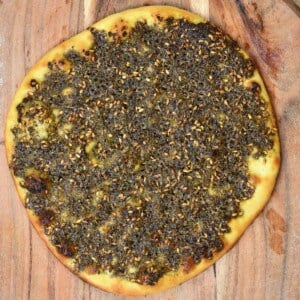This post may contain affiliate links. Please read our disclosure policy.
Enjoy this traditional Middle Eastern flatbread, aka Zaatar bread/Manakish Za’atar, with just 7 ingredients from scratch and 20 minutes of hands-on prep! This zaatar flatbread can be served as a snack, appetizer, or alongside a breakfast spread!

When I was a child, I couldn’t wait for the days when I got to enjoy zaatar manakish from the local Lebanese bakery, even better if a family made it from scratch. This Middle Eastern flatbread is soft and tender, and flavorsome, topped with a flavor-packed za’atar spice and olive oil mixture for a zaatar ‘pizza’ to die for.
As an adult, I’ve dipped my toes in the waters of making several traditional Lebanese recipes from my childhood – including spinach fatayer, Authentic pita (then fattoush with the leftover pita), and batata harra (among others). However, one thing I never bothered to learn for so long was the homemade Middle Easter Flatbread ‘Manakish’.
Living in London, I had access to amazing freshly-baked zaatar manakish from a local bakery and several takeaway options (and at low prices too). It’s only having moved away from London last year that I lost my local fix and decided it was time to give it a go myself – and wow, why haven’t I been doing this all along?!

The recipe and method are super simple, and the smell of the baking fresh zaatar bread from the oven is one of my ultimate ‘cozy’ homey smells ever now. That alone is enough of a reason to bake this at home. Adding to that, the fact that the manakish dough is ridiculously versatile (and I’m talking like ‘all-purpose dough’ levels of versatile) – then this isn’t a recipe to be missed.
Want to save this recipe?
What is Za’atar?
Zaatar is a Middle Eastern spice blend usually comprised of sumac, thyme, and sesame seeds. Optionally, you can also include oregano, cumin, and/or marjoram.

Depending on where you buy it from, it will vary slightly. I use homemade za’atar for this zaatar bread – my blend combined sumac, oregano, sesame seeds, and optionally some thyme.
When combined with olive oil and used to top the Middle Eastern flatbread, you have a truly flavor-packed bread to impress!
The Ingredients
- Manakish dough: I use this Middle Eastern Bread dough for my za’atar flatbread.
- Za’atar spice: I use homemade za’atar, which is practically a pantry staple for me. However, you can also purchase this from several main grocery stores and nearly all Middle Eastern markets.
- Oil: good quality olive oil is my preferred option.


Optional Add-ons
- Cheese: You could mix some shredded halloumi or similar cheese into the za’atar oil blend. Akawi, nabulsi, or feta are other popular cheeses used too. You may also like this cheese manakish recipe.
- Olives: Kalamata olives are quite often served alongside fresh zaatar manakish but also work amazingly, sliced up as a topping.
- Red pepper flakes: this isn’t a traditional addition, but feel free to add some pepper flakes to add a little spice to the za’atar pizza.
How To Make Zaatar Bread
Step 1: Prepare the manakish dough
I use this simple Middle Eastern Dough. This recipe will require about an hour and a half (due to the hour-long proving time), so plan accordingly.
Once the dough is prepared, split it into 5 equal pieces for larger flatbread or to 8 for medium-sized ones. You can weigh it out for complete accuracy, but I just do this by eye.
Roll out the dough pieces with a rolling pin into round pizza-shaped pieces around 1/4-inch in thickness.

Use your fingers to dimple the top of the bread lightly. This will not only help keep the topping in place as the bread bakes, but it will also stop it from puffing up too much in the oven. You can do this step before or after adding the topping. I did it after this particular time, as I forgot to do it before – whoops!
Step 2: Prepare the za’atar topping
Place an inverted tray or a pizza stone in the oven and preheat it to the highest it can reach (mine is 500ºF/260ºC).
In a small bowl, combine the za’atar and olive oil and mix well into a paste similar to pesto rather than a thick paste.

Top each of the Middle Eastern flatbread with some of the za’atar oil blend, leaving about a 1/2-1 inch ‘crust’ at the edges.
Feel free to increase/decrease the amount of topping you add based on how strong you want the flavor.

Step 3: Bake the zaatar bread
Transfer the topped zaatar bread onto the pre-heated inverted oven tray (or pizza stone). Do this carefully, so you don’t burn yourself.
Bake for between 5-7 minutes, until it’s lightly golden-brown, without burning the spices on top.
Remove the manakish za’atar from the oven and allow it to cool slightly. This will allow the topping to ‘dry’ to the flatbread. Then, enjoy – make sure to wrap/cover it with a kitchen towel to keep the bread soft.

How To Store & Reheat
Store: Store the baked zaatar bread in an airtight container in the fridge for up to a week. If you used oil in the dough in place of oil, you could store the bread at room temperature for 3-5 days (covered).
Freezer: Wrap the zaatar manakish tightly with plastic wrap and store it in the freezer for up to three months. Thaw in the refrigerator before enjoying or heat from frozen.
Reheat: You can reheat the bread from frozen in the oven at 250ºF/120ºC until warmed through (20-25 minutes usually). If heating from chilled or room temperature, then reduce the time in the oven.
How To Serve Manakish Za’atar
You can serve this zaatar flatbread as part of a healthy breakfast spread alongside homemade labneh and fresh vegetables like tomatoes, olives, cucumber, mint, etc.
They also do well served as part of a mezze spread alongside dips and dishes like this creamy hummus, smoky baba ganoush, fresh tabouli, etc.

Recipe Notes
- Feel free to adjust the size of the za’atar manakish. You can make “snack-sized” pieces (around 12 with this recipe) or the large pizza-sized ones (like I have) or anywhere in-between.
- If you have any leftover za’atar and olive oil blend, you can use it as a dip for bread. Alternatively, you can use it to make another bread treat – like this Tarte Soleil.
- If you use instant yeast, you don’t need to activate it first. You can mix all of the ingredients at once in the large bowl.
- If you have issues with the za’atar mix burning, you can add a little water to the topping. It will prevent it from burning as easily and can even yield a slightly softer manakish. This isn’t something I’ve tried, but a family member shared the tip with me.
Related Recipes
- Cheese Manakish (Cheese Flatbread)
- The Best Authentic Homemade Pita Bread
- Easy No-Knead Turkish Bread (Ramadan Pide Bread)
- How To Make Simit (Turkish Bagel)
- Lebanese Markouk Saj Bread
If you try this Zaatar bread recipe, then let me know your thoughts and questions in the comments. I’d also really appreciate a recipe rating and would love to see your recreations – just tag @AlphaFoodie.

Middle Eastern Zaatar (Manakish Za’atar)
Ingredients
- Manakish dough
- 1/2 cup zaatar
- 1/2 cup olive oil
Optional Add-Ons:
- Cheese Halloumi, akawi, nabulsi, or feta
- Kalamata Olives halved, sliced, or whole
- red pepper flakes For spice
Instructions
Step 1: Prepare the manakish dough
- I use this simple Middle Eastern Dough. This recipe will require about an hour and a half (due to the hour-long proving time), so plan accordingly.
- Once the dough is prepared, split it into 5 equal pieces for larger breads or 8 pieces for medium-sized breads. You can weigh it out for complete accuracy, but I just do this by eye.
- Roll out the dough pieces with a rolling pin into round pizza-shaped pieces around 1/4-inch in thickness.
- Use your fingers to lightly dimple the top of the bread. This will not only help keep the topping in place as the bread bakes, but it will also stop it from puffing up too much in the oven. You can do this step before or after adding the topping. I did it after this particular time, as I forgot to do it before – whoops!
Step 2: Prepare the za’atar topping
- Place an inverted tray or a pizza stone in the oven and preheat it to the highest it can possibly reach (Mine is 500ºF/260ºC).
- In a small bowl combine the za'atar and olive oil and mix well into a paste similar to pesto rather than a thick paste.
- Top each of the Middle Eastern Flatbread with some of the za'atar oil blend, leaving about a 1/2-1 inch 'crust' at the edges.Feel free to increase/decrease the amount of topping that you add based on how strong you want the flavor to be.
Step 3: Bake the zaatar bread
- Transfer the topped zaatar bread onto the pre-heated inverted oven tray (or pizza stone). Do this carefully, so you don't burn yourself.
- Bake for between 5-7 minutes, until it’s lightly golden-brown, without burning the spices on top.
- Remove the manakish za'atar from the oven and allow it to cool slightly. This will allow the topping to 'dry' to the flatbread. Then, enjoy- make sure to wrap/cover it with a kitchen towel to keep the bread soft.
How To Store & Reheat
- Store: Store the baked zaatar bread in an airtight container in the fridge for up to a week. If you used oil in the dough in place of oil then you can store the bread at room temperature for 3-5 days (covered).Freezer: Wrap the zaatar manakish tightly with plastic wrap and store in the freezer for up to three months, Thaw in the refrigerator before enjoying or heat from frozen.Reheat: You can reheat the bread from frozen in the oven at 250ºF/120ºC until warmed through (20-25 minutes usually). If heating from chilled or room temperature, then reduce the time in the oven.
Notes
- Feel free to adjust the size of the za’atar manakish. You can make ‘snack-sized’ pieces (around 12 with this recipe) or the large pizza-sized ones (like I have) or anywhere in-between.
- If you have any leftover za’atar and olive oil blend then you can use it as a dip for any crust bread. Alternatively, you can use it to make another bread treat – like this tarte soleil.
- If you use instant yeast, you don’t need to activate it first, all of the ingredients can be mixed at once in the large bowl.
- If you have issues with the za’atar mix burning then you can add a little water to the topping. It will prevent it from burning as easily and can even yield a slightly softer manakish. This isn’t something I’ve tried, but a family member shared the tip with me.
Nutrition
Nutrition information is automatically calculated, so should only be used as an approximation.
















Hi! What a great idea for a simple quick lunch. Tell me, am I able to make the Zaatar bread using pita bread pieces? Would be great for a simple lunch.
Hi Karine,
Yes, you can use the Zaatar topping on pita bread you already have. I hope you like it 🙂
This was fabulous! I did add mozzarella cheese as that is what I had on hand along with olives because we love them. I work at a high school with about a 30 percent Arabic staff and they all heartily approved! I truly enjoy embracing ethnic food and trying new things. Thank you for the recipe!
Thank you so much for your comment, Ellen! Glad you enjoyed it.
This is amazing! Made it several times already and all my guests loved it! By far the best recipe on the internet!
Thank you for your feedback Natalie, I’m glad you like it 🙂
Best recipe.
Thank you for your comment, Ricky.